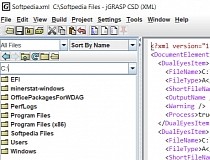

- #Jgrasp java formatting install
- #Jgrasp java formatting full
- #Jgrasp java formatting software
- #Jgrasp java formatting code
In a nutshell, jGRASP can help programmers quickly come up with accurate representations of objects that feature traditional data structures, but the full range of its functions can only be appreciated by those who take the time and discover them one by one. These viewers comes with a dedicated identifier mechanism that can correctly read traditional data structures (such as binary trees, stacks or hash tables) in various objects, then generate a representation of all the data in a user-friendly textbook-like presentation view. Since it was designed to make programmers’ work as easy as possible, jGRASP integrates dynamic object viewers as well as a viewer canvas that can function together with a built-in debugger and Java workbench. The main window of jGRASP enables users to easily browse to the file they want to modify orĬreate a new project from scratch, be it plain text, Ada95, C, C++, Java, VHDL, Python or Objective-C.ĭepending on the programming language, developers can start creating Control Structure Diagrams for all languages previously mentioned, Complexity Profile Graphs for Java and Ada or UML class diagrams solely for Java.
#Jgrasp java formatting install
In order to install jGRASP, one first needs to install Java Runtime Environment, which also means that the application can run on all operating systems supported by Java, i.e.
#Jgrasp java formatting software
JGRASP is one of the lightweight ones, and it was designed to facilitate the generation of software visualizations so as to improve app comprehensibility. are fully aware that a very valuable of their work is the application they use to develop their projects, as a large and heavy IDE (Integrated Development Environment) will slow them down, while a slim and fast one can help them complete their projects in due time. Student.getId(), student.getEmailId(), student.getName(), student.getAge(), student.getGrade()) When you ask jGRASP to create a new file, an embedded window will appear wherein you can write and edit your code. ("%10s %30s %20s %5s %5s", "STUDENT ID", "EMAIL ID", "NAME", "AGE", "GRADE") You can create a new Java source file by selecting File -> New -> Java. Print the list objects in tabular format.

Students.add(new Student("ST003", "Patrick Fixler", 25, 'b')) Students.add(new Student("ST002", "Philip Duncan", 22, 'c')) List& amp amp amp lt Student& amp amp amp gt students = new ArrayList& amp amp amp lt Student& amp amp amp gt () Create an Empty List of Student, And add few objects to the List Public Student(String id, String name, String emailId, int age, But in real time you may fetch the data from a Database or by calling a web service.īelow are the two classes for printing the output in tabular format.For demonstration purpose I have created some random Student objects and added those objects to the List.I have created a domain (POJO) class called Student.java which has some basic attributes like id, emailId, name, age and grade.Īnd the oher class is the main class to print the Student information.
#Jgrasp java formatting code
Thus, you can use format or printf anywhere in your code where you have previously been using print or println. The familiar System.out that you have been using happens to be a PrintStream object, so you can invoke PrintStream methods on System.out.

These methods format and printf are equivalent to one another. The package java.io includes a PrintStream class that has two formatting methods that you can use to replace print and println.To print the results like a table structure we can use either printf() or format() method.īoth the methods belong to the class java.io.PrintStream. In this post, we will see how we can print the results in a table format to the standard output like the image as shown below.


 0 kommentar(er)
0 kommentar(er)
